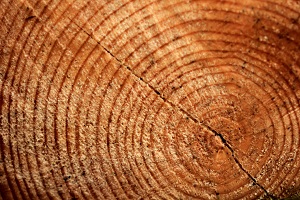
In 1901, astronomer A. E. Douglas had an idea about how to study the effect of sunspot cycles on the Earth. Little did he know that this very idea would ultimately lead to some important discoveries.
How did Douglas develop this idea in the first place? Simple: he cut down a tree, measured it with calipers, and looked at its growth rings. A tree's rings give an invisible record of the conditions during and the time at which the tree lived. In fact, anything made out of wood gives a record of the conditions during its existence.
Now, in the Laboratory of Tree Ring Research at the University of Arizona, researchers use more advanced tools to help calculate answers to the many questions about the time period in which certain trees lived. Here, researchers have collected millions of samples from trees around the world. Director of the lab Thomas Swetnam believes that the lab's archive is like a library. The tree ring sections are like books and the individual rings are like pages.
“We’re taking care of the wood because we know from past experience that we’ll develop new tools and new ways of measuring,” Swetnam said.
Like Douglas before him, Swetnam stated that unforeseeable insights and technological advancements can lead to discoveries and conclusions that are completely new.
Swetnam said, “There’s the known unknown, and then there’s the unknown unknown.” Scientists' discoveries happen at different times; a scientist never knows when he or she might make a breakthrough. Some may even stumble on an answer to a question that they never thought to ask. Swetnam says it can be scary to admit the role serendipity plays in the process of discovery.
Swetnam refers to serendipitous discoveries as “who’d have thunk it discoveries.” An example of one such discovery occurred in the 1970’s was when some astrophysicists wondered if an explosion of a star back in 1054 A.D. had affected the atmospheric composition of the Earth. To test their hypothesis, they decided to test an old tree in the Laboratory of Tree Ring Research archives. In the ring sample of the tree from 1054 A.D., they discovered clear signs of high-energy particles that were emitted by the star—particles that a researcher from Douglas’ time would’ve never even thought to measure.
Clearly, people make discoveries differently. But one thing most people have in common is the excitement of finding the last piece of the puzzle and realizing that the puzzle you finished is completely different than the one you thought you had started.
[Source:
On Earth
]

